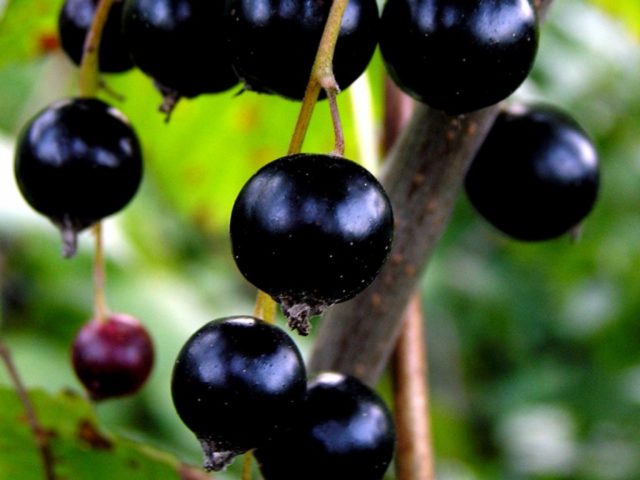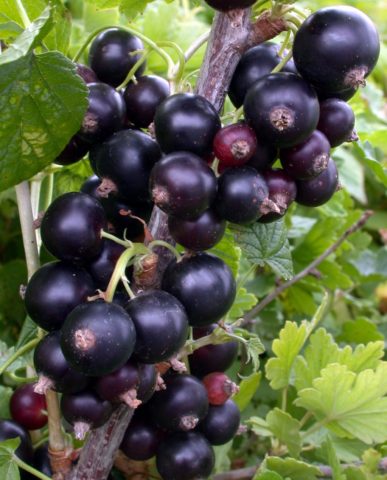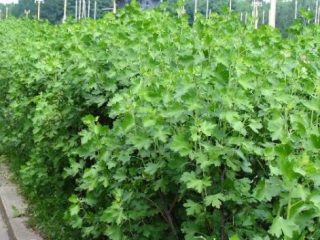Content
Currant Charovnitsa is a relatively new hybrid, which was included in the State Register of Breeding Achievements of the Russian Federation in 2006. This blackcurrant variety was developed by crossing two species: Minai Shmyrev and Brodtorp.
If the necessary standards for planting, care and proper treatment against pests are observed, the shrub will delight its owners with a rich harvest of tasty and healthy berries for a long time.
Description of currant Enchantress
Description of black currant variety Charovnitsa:
Description object | Characteristic |
Bush | It is medium in size, with a fairly wide and spreading branch arrangement. |
Branches (woody) | Thick and elastic. The color range can range from grayish-green to golden brown. |
Top of the plant | It has a brownish-yellowish tint. |
Kidneys | They are medium in size, oval in shape, and pale red in color. |
Leaves | Size – medium, color – rich green, five-lobed shape. |
Leaf plate | Convex, matte color, with a downward slope.The leaf blades have a pointed shape, with the middle one being slightly larger than the widely spaced lateral ones. |
Berries | They have a medium size (from 1.1 to 1.4 g), a round shape, a rich black color and a characteristic glossy shine. The taste is sweet and sour. |
Recommended Growing Regions | Central Black Earth, Middle Volga. |
Characteristics
The black currant variety Charovnitsa is noticeably different from its counterparts in a number of characteristics and descriptions, because thanks to the achievements of modern breeding technologies, scientists have brought this variety to a fairly high level in terms of its unpretentiousness and high yielding abilities.
Drought resistance, frost resistance
The frost resistance of black currant variety Charovnitsa is above average, namely:
- the roots of seedlings can withstand temperatures up to 15 degrees below zero;
- closed buds can withstand temperatures of up to 5 degrees below zero during the return of frost in spring;
- open flowers of this variety during spring frosts will survive at temperatures down to minus 3 degrees;
- the resulting ovary will be preserved if the temperature does not drop below 2 degrees below zero.
The drought resistance of black currant Charovnitsa is also above average. In hot climates and high soil temperatures, the shrub will produce a good berry harvest.
Productivity of the variety
Black currant Charovnitsa is a high-yielding variety of black currant. On average, about 3.2 kg of berries can be harvested from one bush per season.
The berries ripen around mid-July. The fruits do not ripen all at once, so harvesting must be carried out in several stages, and it will be possible to completely pick the entire bush only in August.
Black currant Enchantress is not prone to shedding, however, under the influence of certain natural factors this phenomenon can still be observed. These include:
- a winter that is too frosty and has little snow, when the bush stands uncovered by a snow cap for a long period of time (which can cause the plant buds to freeze);
- severe spring frosts;
- cool weather in the presence of strong winds during the flowering period of the bush can disrupt the process of pollination of the bush, and, therefore, the likelihood of berry set decreases.
Transporting Enchantress blackcurrant berries is quite a difficult task. If it is necessary to transfer the crop over a relatively short distance, then it is preferable to do this at night, when the ambient temperature is much lower than daytime values. If we are talking about long-distance transportation, then it must be carried out in special vehicles equipped with refrigeration chambers. Otherwise, the harvest will be irretrievably lost.
The berry variety is not characterized by crushing, however, in the case when the bush is not properly cared for or is planted in an inappropriate place, this phenomenon is quite possible. If the bush is located in the shade and has a thick, unthinned crown, then the berries will begin to rapidly become smaller, especially for those fruits that are located inside the thickets.In addition, the same applies to old and damaged branches that do not cope with their function of feeding fruits, which is why the berries on such branches will also differ significantly in size from their neighbors on healthy branches. In order to avoid such phenomena, it is necessary:
- trim bushes on time and correctly;
- get rid of diseased branches in a timely manner.
Application area
Black currant berries of the Charovnitsa variety have a fairly wide range of applications, ranging from fresh harvest consumption to technical processing of raw materials. To implement all of the above, it is necessary to take into account the limited storage capacity of the Charovnitsa black currant berries and the need for transportation over long distances exclusively using a specially designed means of transport.
Pros and cons of the variety
Like any other variety of currant, black currant Charovnitsa has its advantages and disadvantages.
The advantages of the variety include:
- high productivity, which is stable;
- precocity;
- resistance to fungal diseases, such as powdery mildew.
Of the possible disadvantages of the black currant variety Charovnitsa, only one can be identified - low resistance to a parasite such as bud mite.
Reproduction methods
Propagation of black currant variety Charovnitsa can occur in several ways.
Reproduction option | Characteristic |
Propagation by seeds | The method, as a rule, is used only by specialists (to breed new plant species). In the conditions of country gardening, it is not recommended to resort to its use, since the final result may differ significantly from the “original”. |
Propagation by cuttings with a lignified trunk | This method is much more effective than the previous one. Reproduction must be carried out in spring or autumn, following all the necessary recommendations. |
Propagation by green cuttings | The method is quite effective, but more labor-intensive, since initially the plant must be planted in a greenhouse or hotbed, and only after at least a month, in the natural environment. |
Propagation by top cuttings | A very complex and troublesome propagation method, since it requires not only the presence of special soil, but also equipment that will maintain certain conditions of soil and air humidity in which the plant will grow. |
Reproduction by layering | A highly effective method of propagation, which gives a 100% guarantee of seedling survival if the plan is correctly implemented. It only takes 1 year to get a new plant this way. |
Propagation by dividing bushes | The fastest way that allows you to get several plants from one by simple division. In addition, there will be no need for additional strengthening of seedlings. |
Planting and caring for Charovnitsa currants
It is recommended to plant black currants of the Charovnitsa variety in spring or autumn. At the same time, in order to carry out this activity correctly, it is necessary to follow a number of important rules:
- planting should be carried out in a well-lit and sufficiently dry place;
- It is preferable to plant the crop along fences in order to protect the bushes from the wind.
The algorithm of actions during disembarkation should be as follows:
- Black currant seedlings of the Charovnitsa variety should be planted to a depth of approximately 7 - 10 cm;
- the branches of a young plant should be cut to half the length (or 2/3);
- in the immediate vicinity, to improve the quality of the harvest (the size of the berries, their taste), it is recommended to plant several different varieties of currants;
- the distance between plantings must be at least 1.5 m;
- When planting, it is important to nourish the soil with organic fertilizers.
Aftercare
The health of the plant and the quality of the resulting harvest directly depend on the quality of further care of the Charovnitsa blackcurrant variety after planting. Basic shrub care activities should include:
- timely pruning of branches (thinning and removal of “sick” and old (more than 5 years) shoots);Important! Branches need to be trimmed close to the ground.
- The “correct” bush should have about 15 shoots (3 from each year);
- It is recommended to water the plant approximately 2 - 3 times a week. An adult bush will require 1 bucket of water. Watering can be done 2 times a day. Particularly abundant watering is recommended during the fruiting period of the bush;
- It is recommended to feed the Enchantress with organic fertilizers annually in the spring;
- Despite the frost resistance of the variety, it is worth insulating the tree trunk circle with horse manure for the winter. This provides protection from winters with little snow and too early frosts;
- For the winter, it is also recommended to bend the currant branches to the ground and secure their ends with bricks.
Since this variety is very popular with rodents, it is worth taking care that they do not harm the bush. For this purpose, you can use one of the following methods:
- mechanical (tie the stems with pine spruce branches, use a special plastic mesh, compact the snow around the bush, treat the bush with a mixture of clay and horse manure, put poisoned bait);
- chemical (use special chemical compounds that have a detrimental effect on rodents).
Pests and diseases
The most important pest of black currant variety Charovnitsa is the currant bud mite.
In addition to this pest, the following can also harm the bush:
- bud moth;
- redcurrant aphid;
- spider mite;
- currant gall midges;
- currant borer;
- glass of currant;
- gooseberry moth.
To control pests, both traditional methods and special insecticides are used.
Conclusion
Currant Charovnitsa is a discovery of Russian breeders. This berry bush is very unpretentious in its care, produces an abundant harvest of berries and, in addition, is quite frost-resistant. All these qualities distinguish it favorably from the general mass of blackcurrant species and varieties and indicate the possibility of stopping the gardener’s choice in its favor.













